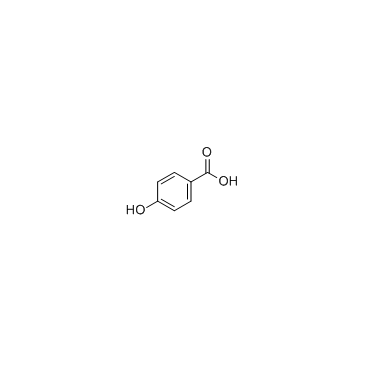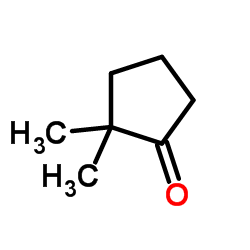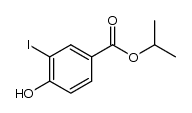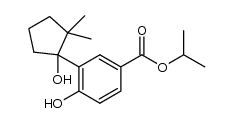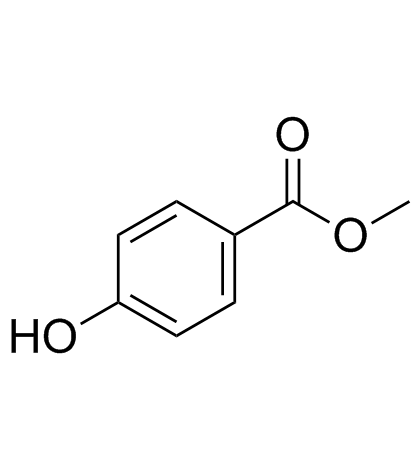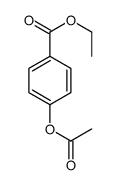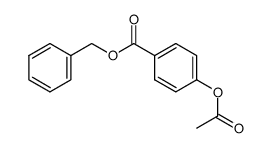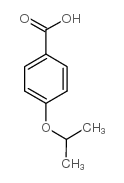4191-73-5
| 中文名 | 4-羟基苯甲酸异丙酯 |
|---|---|
| 英文名 | Isopropylparaben |
| 中文别名 |
对羟基苯甲酸异丙酯
尼泊金异丙酯 |
| 英文别名 |
1-methylethyl4-hydroxybenzoate
iso-propyl p-hydroxy benzoate Isopropyl4-hydroxybenzoate Isopropylparaben 4-hydroxybenzoic acid isopropyl ester ISOPROPYLPARA-HYDROXYBENZOATE MFCD00016468 Isopropyl 4-hydroxybenzoate 4-(1-Isopropoxyvinyl)phenol p-Oxybenzoesaureisopropylester Benzoic acid, 4-hydroxy-, 1-methylethyl ester (9CI) EINECS 224-069-3 Benzoic acid, 4-hydroxy-, 1-methylethyl ester Isopropyl 4-Hydroxubenzoate Isopropylhydroxybenzoate isopropyl paraben |
| 描述 | 4-羟基苯甲酸异丙酯(尼泊金异丙酯)是一种抗菌和抗氧化剂[1]。 |
|---|---|
| 相关类别 | |
| 参考文献 |
| 密度 | 1.1±0.1 g/cm3 |
|---|---|
| 沸点 | 286.9±13.0 °C at 760 mmHg |
| 熔点 | 84-86°C |
| 分子式 | C10H12O3 |
| 分子量 | 180.20 |
| 闪点 | 120.4±12.6 °C |
| 精确质量 | 180.078644 |
| PSA | 46.53000 |
| LogP | 2.74 |
| 外观性状 | 固体;White powder to lump |
| 蒸汽压 | 0.0±0.6 mmHg at 25°C |
| 折射率 | 1.530 |
| 储存条件 | 避光,通风干燥处,密封保存 |
| 稳定性 | 通常对水是不危害的,若无政府许可,勿将材料排入周围环境 |
| 水溶解性 | 可溶于:甲醇 |
| 分子结构 | 1、 摩尔折射率:49.13 2、 摩尔体积(m3/mol):159.1 3、 等张比容(90.2K):404.0 4、 表面张力(dyne/cm):41.5 5、 极化率(10 -24cm 3):19.47 |
| 计算化学 | 1.疏水参数计算参考值(XlogP):无 2.氢键供体数量:1 3.氢键受体数量:3 4.可旋转化学键数量:3 5.互变异构体数量:4 6.拓扑分子极性表面积46.5 7.重原子数量:13 8.表面电荷:0 9.复杂度:169 10.同位素原子数量:0 11.确定原子立构中心数量:0 12.不确定原子立构中心数量:0 13.确定化学键立构中心数量:0 14.不确定化学键立构中心数量:0 15.共价键单元数量:1 |
| 更多 | 1. 性状:粉末 2. 密度):不确定 3. 相对蒸汽密度(,空气=1):不确定 4. 熔点(ºC):84-86 5. 沸点(ºC):不确定 6. 沸点(ºC, 5mmHg):160 7. 折射率:不确定 8. 闪点(ºC):不确定 9. 比旋光度(º):不确定 10. 自燃点或引燃温度(ºC):不确定 11. 蒸气压(kPa,25ºC):不确定 12. 饱和蒸气压(kPa,60ºC):不确定 13. 燃烧热(KJ/mol):不确定 14. 临界温度(ºC):不确定 15. 临界压力(KPa):不确定 16. 油水(辛醇/水)分配系数的对数值:不确定 17. 爆炸上限(%,V/V):不确定 18. 爆炸下限(%,V/V):不确定 19. 溶解性:不确定 |
|
Section I.Chemical Product and Company Identification Chemical NameIsopropyl 4-Hydroxybenzoate [for Biochemical Research] Portland OR Benzoic acid, 4-hydroxy-, 1-methylethyl ester (CA Synonym INDEX NAME);
4-Hydroxybenzoic Acid Isopropyl Ester; Isopropylparaben Chemical FormulaC10H12O3 4191-73-5 CAS Number Section II.Composition and Information on Ingredients Chemical NameCAS Number Percent (%)TLV/PELToxicology Data Isopropyl 4-Hydroxybenzoate4191-73-5Min. 99.0 (T) Not available.Mouse LD50 (subcutaneous) 1900 [for Biochemical Research] mg/kg Section III. Hazards Identification Harmful if ingested or inhaled. Minimize exposure to this material. Severe overexposure can result in injury or death. Acute Health Effects Irritating to eyes and skin on contact. Inhalation causes irritation of the lungs and respiratory system. Inflammation of the eye is characterized by redness, watering, and itching. Skin inflammation is characterized by itching, scaling, reddening, or, occasionally, blistering. Skin contact may result in sensitization. Always cover all exposed skin with an impermeable layer and use proper eye protection. A OSHA/MSHA approved dust and vapor respirator is required when working with this material. Follow safe industrial hygiene practices and always wear proper protective equipment when handling this compound. Chronic Health EffectsCARCINOGENIC EFFECTS : Not available. MUTAGENIC EFFECTS : Not available. TERATOGENIC EFFECTS : Not available. DEVELOPMENTAL TOXICITY: Not available. Repeated or prolonged exposure to this compound is not known to aggravate existing medical conditions. Section IV.First Aid Measures Eye ContactCheck for and remove any contact lenses. In case of contact, immediately flush eyes with plenty of water for at least 15 minutes. Get medical attention. Skin ContactIn case of contact, immediately flush skin with plenty of water. Remove contaminated clothing and shoes. Wash clothing before reuse. Thoroughly clean shoes before reuse. Get medical attention. If the victim is not breathing, perform mouth-to-mouth resuscitation. Loosen tight clothing such as a collar, tie, belt or Inhalation waistband. If breathing is difficult, oxygen can be administered. Seek medical attention if respiration problems do not improve. INDUCE VOMITING by sticking finger in throat. Lower the head so that the vomit will not reenter the mouth and throat. Ingestion Loosen tight clothing such as a collar, tie, belt or waistband. If the victim is not breathing, perform mouth-to-mouth resuscitation. Examine the lips and mouth to ascertain whether the tissues are damaged, a possible indication that the toxic material was ingested; the absence of such signs, however, is not conclusive. Section V.Fire and Explosion Data Not available. May be combustible at high temperature.Auto-Ignition Flammability Flash PointsFlammable LimitsNot available. Not available. Combustion ProductsThese products are toxic carbon oxides (CO, CO2). Fire HazardsNot available. Risks of explosion of the product in presence of mechanical impact: Not available. Explosion Hazards Risks of explosion of the product in presence of static discharge: Not available. Fire Fighting MediaSMALL FIRE: Use DRY chemical powder. LARGE FIRE: Use water spray, fog or foam. DO NOT use water jet. and Instructions Consult with local fire authorities before attempting large scale fire-fighting operations. Continued on Next Page Isopropyl 4-Hydroxybenzoate [for Biochemical Research] Section VI.Accidental Release Measures Spill CleanupHarmful material. Irritating material. Skin sensitizing material. Use a shovel to put the material into a convenient waste disposal container. Consult federal, state, and/or local authorities for Instructions assistance on disposal. Section VII. Handling and Storage HARMFUL. IRRITANT. SKIN SENSITIZER. Keep away from heat. Mechanical exhaust required. When not in use, tightly Handling and Storage seal the container and store in a dry, cool place. Avoid excessive heat and light. Do not breathe dust. Information Always store away from incompatible compounds such as oxidizing agents. Section VIII. Exposure Controls/Personal Protection Use process enclosures, local exhaust ventilation, or other engineering controls to keep airborne levels below recommended Engineering Controls exposure limits. If user operations generate dust, fume or mist, use ventilation to keep exposure to airborne contaminants below the exposure limit. Splash goggles. Lab coat. Dust respirator. Boots. Gloves. Suggested protective clothing might not be sufficient; consult a Personal Protection specialist BEFORE handling this product. Be sure to use a MSHA/NIOSH approved respirator or equivalent. Exposure LimitsNot available. Section IX. Physical and Chemical Properties Solid. (Powder, flake. White.)Solubility Physical state @ 20°CSoluble in methanol. Not available. Specific Gravity 180.20 Molecular WeightPartition CoefficientLOG Pow: 2.39 Boiling Point160°C (320°F) @ 5 mmHgVapor PressureNot applicable. 86°C (186.8°F)Not available. Melting PointVapor Density Refractive IndexNot available.VolatilityNot available. Not available.Not available. Critical TemperatureOdor ViscosityNot available.TasteNot available. Section X.Stability and Reactivity Data This material is stable if stored under proper conditions. (See Section VII for instructions) Stability Conditions of InstabilityAvoid excessive heat and light. Incompatibilities Reactive with oxidizing agents. Section XI. Toxicological Information DH2250000 RTECS Number Routes of ExposureEye Contact. Ingestion. Inhalation. Mouse LD50 (subcutaneous) 1900 mg/kg Toxicity Data Chronic Toxic EffectsCARCINOGENIC EFFECTS : Not available. MUTAGENIC EFFECTS : Not available. TERATOGENIC EFFECTS : Not available. DEVELOPMENTAL TOXICITY: Not available. Repeated or prolonged exposure to this compound is not known to aggravate existing medical conditions. Harmful if ingested or inhaled. Minimize exposure to this material. Severe overexposure can result in injury or death. Acute Toxic Effects Irritating to eyes and skin on contact. Inhalation causes irritation of the lungs and respiratory system. Inflammation of the eye is characterized by redness, watering, and itching. Skin inflammation is characterized by itching, scaling, reddening, or, occasionally, blistering. Skin contact may result in sensitization. Always cover all exposed skin with an impermeable layer and use proper eye protection. A OSHA/MSHA approved dust and vapor respirator is required when working with this material. Follow safe industrial hygiene practices and always wear proper protective equipment when handling this compound. Continued on Next Page Isopropyl 4-Hydroxybenzoate [for Biochemical Research] Section XII.Ecological Information EcotoxicityNot available. Not available. Environmental Fate Section XIII. Disposal Considerations Recycle to process, if possible. Consult your local regional authorities. You may be able to dissolve or mix material with a Waste Disposal combustible solvent and burn in a chemical incinerator equipped with an afterburner and scrubber system. Observe all federal, state and local regulations when disposing of the substance. Section XIV. Transport Information Not a DOT controlled material (United States). DOT Classification Not applicable. PIN Number Proper Shipping NameNot applicable. Packing Group (PG)Not applicable. DOT Pictograms Section XV. Other Regulatory Information and Pictograms TSCA Chemical InventoryThis product is NOT on the EPA Toxic Substances Control Act (TSCA) inventory. The following notices are required by 40 CFR 720.36 (C) for those products not on the inventory list: (EPA) (i) These products are supplied solely for use in research and development by or under the supervision of a technically qualified individual as defined in 40 CFR 720.0 et sec. (ii) The health risks of these products have not been fully determined. Any information that is or becomes available will be supplied on an MSDS sheet. WHMIS ClassificationNot available. On DSL. (Canada) EINECS Number (EEC) 224-069-3 EEC Risk StatementsR20/21/22- Harmful by inhalation, in contact with skin and if swallowed. R36/37/38- Irritating to eyes, respiratory system and skin. R43- May cause sensitization by skin contact. SECTION 16 - ADDITIONAL INFORMATION N/A |
|
毒理学数据: 1、急性毒性:大鼠皮下LD50:1900mg/kg 2、 主要的刺激性影响 在皮肤上面:刺激皮肤和粘膜 在眼睛上面:刺激的影响 过敏作用:没有已知的敏化影响 生态学数据: 通常对水是不危害的,若无政府许可,勿将材料排入周围环境 CHEMICAL IDENTIFICATION
HEALTH HAZARD DATAACUTE TOXICITY DATA
|
|
~89% 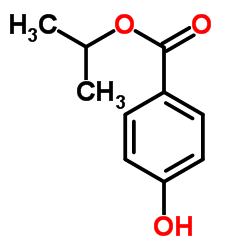
4191-73-5 |
| 文献:Srinivas; Mahender; Das, Biswanath Synthesis, 2003 , # 16 p. 2479 - 2482 |
|
~56% 
4191-73-5 |
| 文献:Caille, Seb; Crockett, Rich; Ranganathan, Krishnakumar; Wang, Xiang; Woo, Jacqueline C. S.; Walker, Shawn D. Journal of Organic Chemistry, 2011 , vol. 76, # 13 p. 5198 - 5206 |
|
~83% 
4191-73-5 |
| 文献:Srinivas; Mahender; Das, Biswanath Synthesis, 2003 , # 16 p. 2479 - 2482 |
|
~% 
4191-73-5 |
| 文献:Srinivas; Mahender; Das, Biswanath Synthesis, 2003 , # 16 p. 2479 - 2482 |
|
~% 
4191-73-5 |
| 文献:Rosenmund et al. Archiv der Pharmazie (Weinheim, Germany), 1953 , vol. 286, p. 324,327 |
| 上游产品 6 | |
|---|---|
| 下游产品 5 | |



